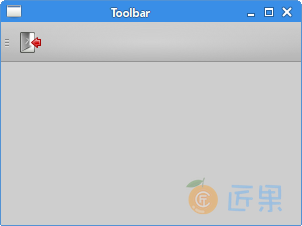菜单栏包含了所有的命令,工具栏就是常用的命令的集合。
#!/usr/bin/python3
# -*- coding: utf-8 -*-
"""
ZetCode PyQt5 tutorial
This program creates a toolbar.
The toolbar has one action, which
terminates the application, if triggered.
Author: Jan Bodnar
Website: zetcode.com
Last edited: August 2017
"""
import sys
from PyQt5.QtWidgets import QMainWindow, QAction, qApp, QApplication
from PyQt5.QtGui import QIcon
class Example(QMainWindow):
def __init__(self):
super().__init__()
self.initUI()
def initUI(self):
exitAct = QAction(QIcon('exit24.png'), 'Exit', self)
exitAct.setShortcut('Ctrl+Q')
exitAct.triggered.connect(qApp.quit)
self.toolbar = self.addToolBar('Exit')
self.toolbar.addAction(exitAct)
self.setGeometry(300, 300, 300, 200)
self.setWindowTitle('Toolbar')
self.show()
if __name__ == '__main__':
app = QApplication(sys.argv)
ex = Example()
sys.exit(app.exec_())
上面的例子中,我们创建了一个工具栏。这个工具栏只有一个退出应用的动作。
exitAct = QAction(QIcon('exit24.png'), 'Exit', self)
exitAct.setShortcut('Ctrl+Q')
exitAct.triggered.connect(qApp.quit)
和上面的菜单栏差不多,这里使用了一个行为对象,这个对象绑定了一个标签,一个图标和一个快捷键。这些行为被触发的时候,会调用QtGui.QMainWindow的quit方法退出应用。
self.toolbar = self.addToolBar('Exit')
self.toolbar.addAction(exitAct)
用addToolBar()创建工具栏,并用addAction()将动作对象添加到工具栏。
